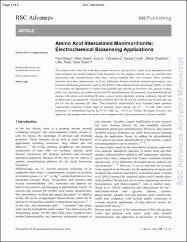Amino acid intercalated montmorillonite: electrochemical biosensing applications

View/
Date
2014Author
Demir, FilizDemir, Bilal
Yalçınkaya, Esra E.
Çevik, Serdar
Demirkol, Dilek Odacı
Anık, Ülkü
Timur, Suna
Metadata
Show full item recordAbstract
The present work is the first that includes the use of glycine (Gly), lysine (Lys) and glutamic acid (Glu) modified clay mineral matrices in the biosensors. For this purpose, initially, Gly, Lys and Glu were intercalated with montmorillonite (Mt), thus, various modified Mts were obtained. These modified materials were then characterized via X-ray diffraction, Fourier transform infrared spectroscopy, zeta potential and thermal gravimetric analysis (TGA/DTG) and scanning electron microscopy (SEM). In order to investigate the applicability of amino acid modified clay minerals in biosensor areas, glucose oxidase (GOx) was selected as the model enzyme and a GOx based biosensor was prepared. After immobilizing the enzyme with amino acid modified Mt onto a glassy carbon electrode, working conditions like pH and modifier type were optimized. Among the modified Mts, Gly-Mt was the optimum clay mineral type and pH 4.0 was the optimum pH value. Then analytical characteristics were examined under optimum experimental conditions. The linear range of optimum sensor design was 0.1-1.0 mM within the kinetic parameters of an immobilized enzyme K-m(app) m = 0.7 mM, I-max = 107.8 nA. Finally, the developed biosensor was applied to real samples where the results were compared with a spectrophotometric reference method.

















